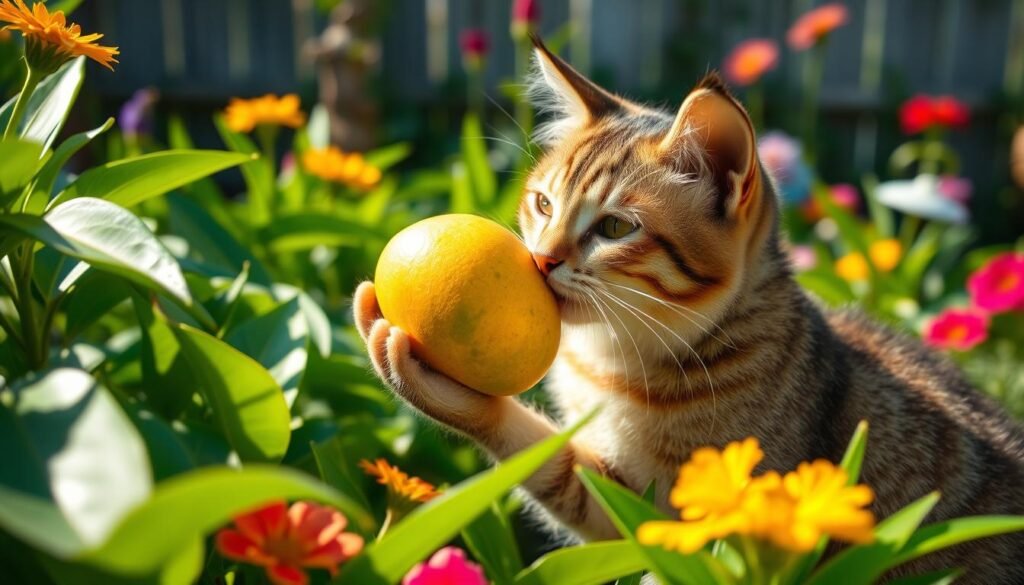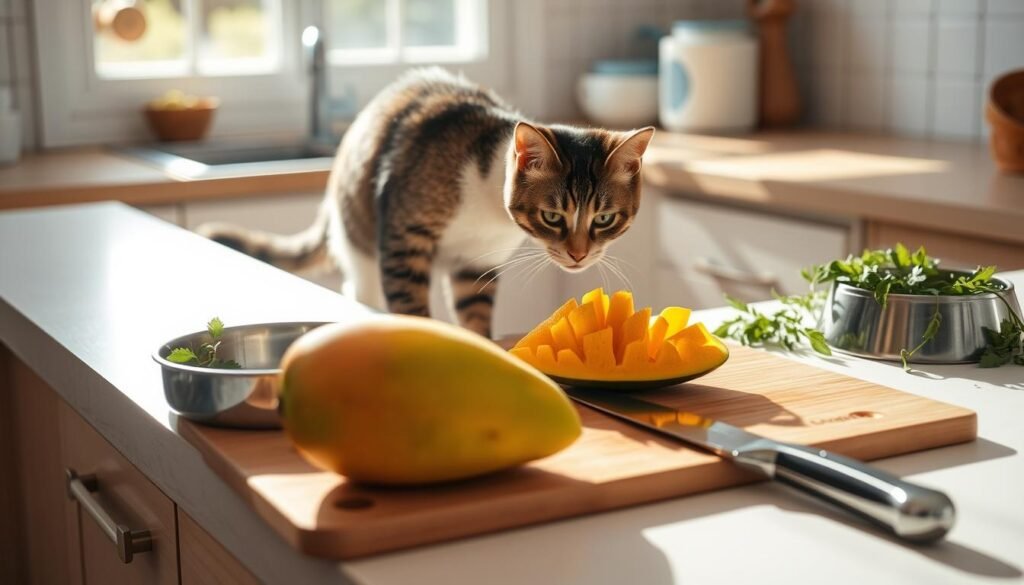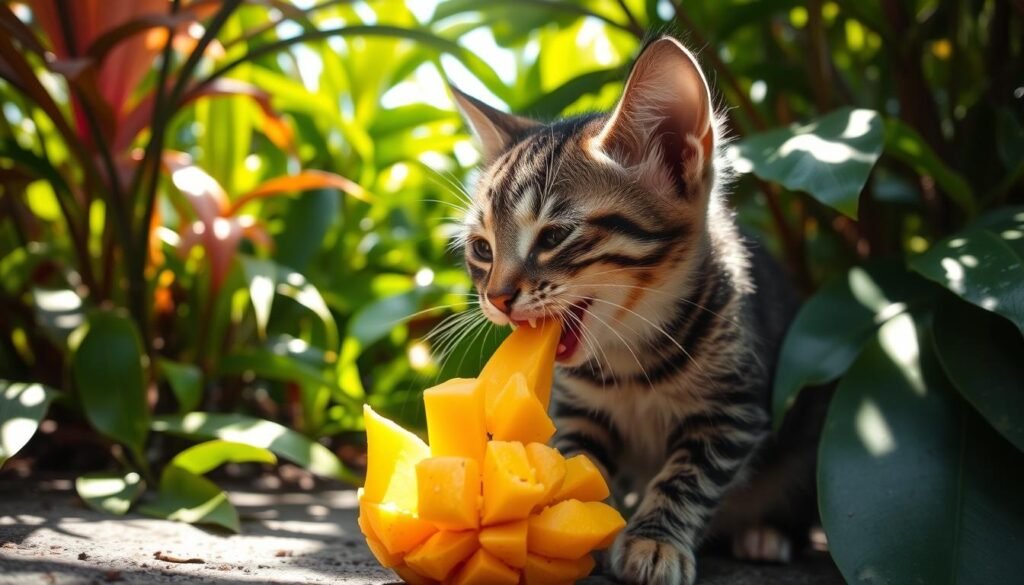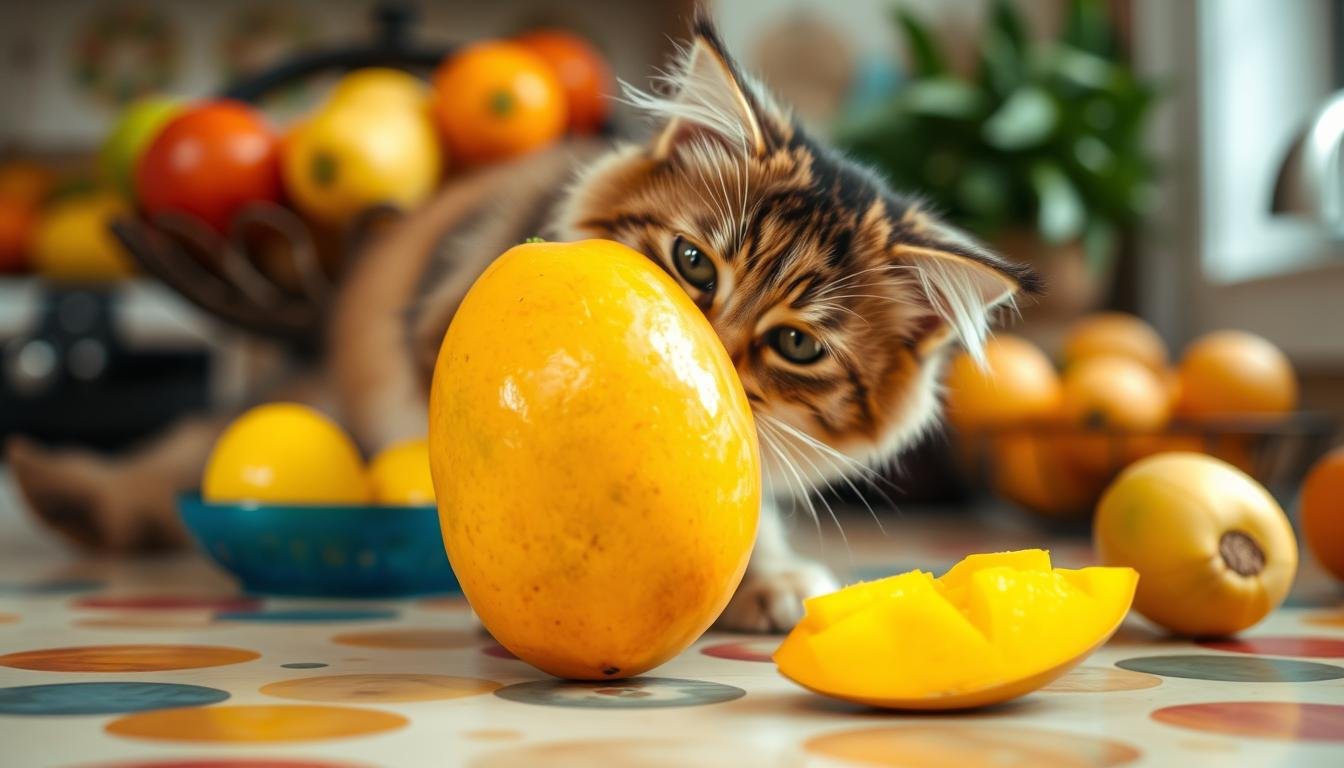As a cat owner, it’s key to make sure the food we give them is safe and healthy. I often think about whether fruits like mango are good for my cat. Is it okay for cats to eat mango? This question is important for understanding what’s best for our feline friends.
Vets say we should be careful when introducing new foods to our cats. This is why I’m always mindful of what I feed my cat. I want to make sure their diet is right, including whether they can eat mango.
I want to give my cat the best nutrition possible. This means knowing if mangoes are good for them. In this article, we’ll look into cat nutrition and give you the facts about mangoes for your cat.
Key Takeaways
- Understanding cat nutrition is crucial for making informed decisions about your cat’s diet.
- Mango safety for cats is a key consideration when introducing new foods to their diet.
- Can cats eat mango is a common question among cat owners, and the answer requires careful consideration of cat nutrition and mango safety for cats.
- Introducing new foods to a cat’s diet should be done with caution to avoid adverse reactions.
- Consulting with a veterinarian is essential for ensuring your cat’s diet is safe and healthy.
- Staying informed about cat nutrition and mango safety for cats is vital for responsible cat ownership.
Can Cats Eat Mango? The Quick Answer
As a cat owner, knowing the risks of mangoes is key. Mangoes aren’t toxic to cats, but they can cause problems if eaten too much. I’ve looked into the research and expert views to give you a full picture of mango safety for cats.
When it comes to feline health, mangoes can upset your cat’s stomach if eaten too much. It’s important to watch how your cat acts and adjust their cat food as needed. Also, knowing about mango toxicity and its dangers is crucial.
Here are some important things to think about when giving mangoes to your cat:
- Start with small portions to gauge your cat’s tolerance
- Monitor your cat’s behavior and adjust their diet as needed
- Be aware of the potential risks associated with mango toxicity
What the Research Says
Research shows mangoes aren’t toxic to cats, but they can still cause issues. It’s important to know the risks and take steps to avoid them. By being cautious, you can help keep your cat healthy and happy.
Understanding Your Cat’s Digestive System
As a cat owner, knowing how your cat’s digestive system works is key. Cats need a diet full of protein and fat from animal sources. Their system is made to handle lots of protein and fat but can be sensitive to diet changes.
Cats have a special digestive system for their meat-based diet. Their digestive system is shorter than herbivores, and their intestines quickly absorb nutrients. This is why feline nutrition is crucial for their pet health.
Important factors for your cat’s digestive system include:
- Diet: Cats need a diet rich in protein and fat from animal sources.
- Digestive enzymes: Cats have unique digestive enzymes for their carnivorous diet.
- Intestinal health: A healthy intestinal tract is key for your cat’s overall health.
Understanding your cat’s digestive system helps you make better diet choices. This is important when adding new foods, like mangoes, to their diet.
The Nutritional Profile of Mangoes
Exploring mango nutrition is exciting. We’ll look at the good and bad for our cats. Mangoes are full of vitamins, minerals, and fiber. They’re a healthy choice for us and might be good for cats too.
Mangoes have vitamins A and C, potassium, and fiber. But, they also have a lot of sugar. This is something to think about for our cats.
Key Vitamins and Minerals
Here are some important nutrients in mangoes:
- Vitamin A: good for eyes and immune system
- Vitamin C: boosts immune system and collagen
- Potassium: keeps blood pressure healthy
- Fiber: helps digestion and blood sugar
Sugar Content Concerns
Mangoes are nutritious but have a lot of sugar. As cat owners, we must think about the risks. This is important when considering mangoes as cat food alternatives.
Fiber Benefits and Risks
Fiber in mangoes is good for digestion and blood sugar. But, adding mangoes to your cat’s diet slowly is key. This helps avoid digestive problems.
Potential Health Benefits for Your Feline Friend
As a cat owner, I always look for the best for my pet. I consider foods like mangoes for their health benefits. Mangoes aren’t essential, but they might help. They have anti-inflammatory properties that could aid cats with health issues.
Mangoes are also packed with antioxidants. These can protect cats from cell damage and lower disease risks. This shows how mangoes can be good for your cat’s nutrition.

It’s important to know the good and bad of different foods for your cat. By learning about the benefits and risks, you can choose the best for your cat’s health and nutrition.
Possible Risks and Side Effects
As a cat owner, knowing the risks of mangoes is key. Mangoes can be tasty but also harmful to cats. Cats might face digestive problems, allergic reactions, or issues with sugar if they eat mangoes.
Cats can get sick from mangoes, leading to vomiting, diarrhea, and upset stomachs. The high sugar in mangoes is hard for cats to digest. Some cats might also have allergies to mangoes, causing itching, scratching, and skin problems.
Feeding too much mango can lead to obesity, dental issues, and diabetes risks. To avoid these, give mangoes to your cat sparingly and as a rare treat.
- Digestive issues: vomiting, diarrhea, stomach upset
- Allergic reactions: itching, scratching, skin irritation
- Sugar-related concerns: obesity, dental problems, increased risk of diabetes
Knowing these risks helps keep your cat safe and healthy. Always talk to your vet before adding new foods, like mangoes, to your cat’s diet.
How to Safely Prepare Mango for Your Cat
As a cat owner, it’s crucial to prepare mangoes safely. This is to avoid any bad reactions. When preparing mango for your cat, safety should be your main concern.
Think about how mangoes can fit into your cat’s diet. Since cats should only have a little mango, it’s important to cut it carefully. This prevents choking and makes it easier for your cat to eat.
Proper Portion Sizes
Start by cutting the mango into small pieces. This makes it safe for your cat to eat and helps with digestion. A good rule is to give about 1-2 teaspoons of mango for every 10 pounds of your cat’s weight.
Preparation Steps
First, wash the mango well and remove the skin and pit. Then, cut it into small pieces or blend it. You can also mix it with your cat’s food for a tasty meal. Always introduce new foods slowly and in small amounts to avoid upset stomachs.

By following these steps, you can make sure your cat enjoys mango safely. Always keep safety and nutrition in mind when adding new foods to your cat’s diet.
Signs Your Cat May Not Tolerate Mango
As a cat owner, knowing when your cat doesn’t like mangoes is key. Cat health signs can be small but mean a big problem if ignored. Mangoes can upset your cat’s stomach, cause allergies, or other bad reactions.
Look out for vomiting, diarrhea, or feeling very tired. If your cat shows these signs after eating mango, act fast. Feline nutrition is very important, and new foods can upset it.
Here are some key signs to look out for:
- Vomiting or diarrhea
- Lethargy or lack of appetite
- Itching or skin irritation
- Difficulty breathing
If you think your cat doesn’t like mangoes, talk to your vet. They can tell you what to do next. They might suggest other foods that are safe for your cat.
Knowing the signs of mango intolerance helps keep your cat healthy. Every cat is different, so what works for one might not work for another. Always put your cat’s health first and get vet advice if you’re worried.
| Signs of Mango Intolerance | What to Do |
|---|---|
| Vomiting or diarrhea | Consult with your veterinarian |
| Lethargy or lack of appetite | Monitor your cat’s behavior and adjust their diet as needed |
| Itching or skin irritation | Provide a balanced diet and consider adding supplements |
Best Practices for Introducing Mango to Your Cat’s Diet
Introducing mango to your cat’s diet should be done slowly and with close watch. As a caring cat owner, you want to make sure your cat can handle this new food. A careful cat diet introduction is key to avoid digestive problems and health issues.
Begin by giving a small amount of mango as a treat. Watch your cat closely for any signs of discomfort or allergies. This step is important to see if mango is safe for your cat’s feline nutrition plan. A mango introduction should be done carefully to avoid any bad reactions.

First-Time Feeding Tips
- Start with a small amount of mango, about 1-2 teaspoons, to test your cat’s tolerance.
- Choose a ripe, fresh mango to ensure the best flavor and nutritional value.
- Avoid giving your cat mango seeds, pits, or skin, as they can cause digestive issues.
Monitoring Guidelines
After introducing mango to your cat’s diet, watch their behavior, appetite, and stool quality closely. If you see signs of discomfort, like vomiting, diarrhea, or lethargy, see your vet right away. By following these tips and watching your cat’s health, you can add mango safely to their cat diet introduction plan.
Alternative Fruits Safe for Cats
As a cat owner, it’s key to find safe fruits for your pet. Mangoes are tasty, but there are other options. It’s important to give cats a varied and healthy diet. Some fruits, like bananas and apples, are safer than grapes and raisins.
There are many cat-safe fruits to choose from. Here are a few fruit alternatives:
- Blueberries: rich in antioxidants and fiber
- Strawberries: high in vitamin C and potassium
- Pineapple: a good source of vitamin C and manganese
But, there are fruits to avoid, like:
- Grapes and raisins: can cause kidney failure in cats
- Citrus fruits: can cause stomach upset and digestive issues
- Avocado: can cause vomiting and diarrhea in cats
Knowing the right fruit alternatives helps keep your cat’s diet balanced. Always introduce new fruits slowly and in small amounts. This prevents any bad reactions.
When to Contact Your Veterinarian
As a cat owner, knowing when to get veterinary care is key. This is true if you worry about your cat eating mangoes. If your cat seems sick or has a bad reaction after eating mangoes, get help fast.
Some cat health concerns need a vet’s help. These include tummy troubles, allergies, or sugar issues. If you see these signs, call your vet right away for advice.
It’s also important to make sure your cat eats well. If you want to add mangoes to their diet, talk to your vet first. They can tell you if it’s safe and good for your cat.
Knowing when your cat is sick is crucial. Always get vet help quickly if you notice problems. By listening to your vet about veterinary care and feline nutrition, you can keep your cat healthy and happy.
Conclusion
The safety of mangoes for cats is a complex issue. It needs careful thought. Mangoes have good nutrients and fiber, but they can also cause problems like digestive issues and sugar concerns. This means you should think carefully before giving mangoes to your cat.
Every cat is different, and their health and diet needs are unique. So, it’s important to focus on what’s best for your cat. This way, you can make sure they get the good stuff from mangoes without any bad effects.
Talking to your vet about cat health, mango safety, and feline nutrition is key. They can help you figure out the right amount and how to prepare mangoes for your cat. This way, you can make sure your cat gets the benefits of mangoes without any harm.
Being a good pet parent means paying attention to your cat’s diet. With what you’ve learned here, you can decide if mangoes are right for your cat. Always put your cat’s health first and talk to your vet if you have any questions or worries.

